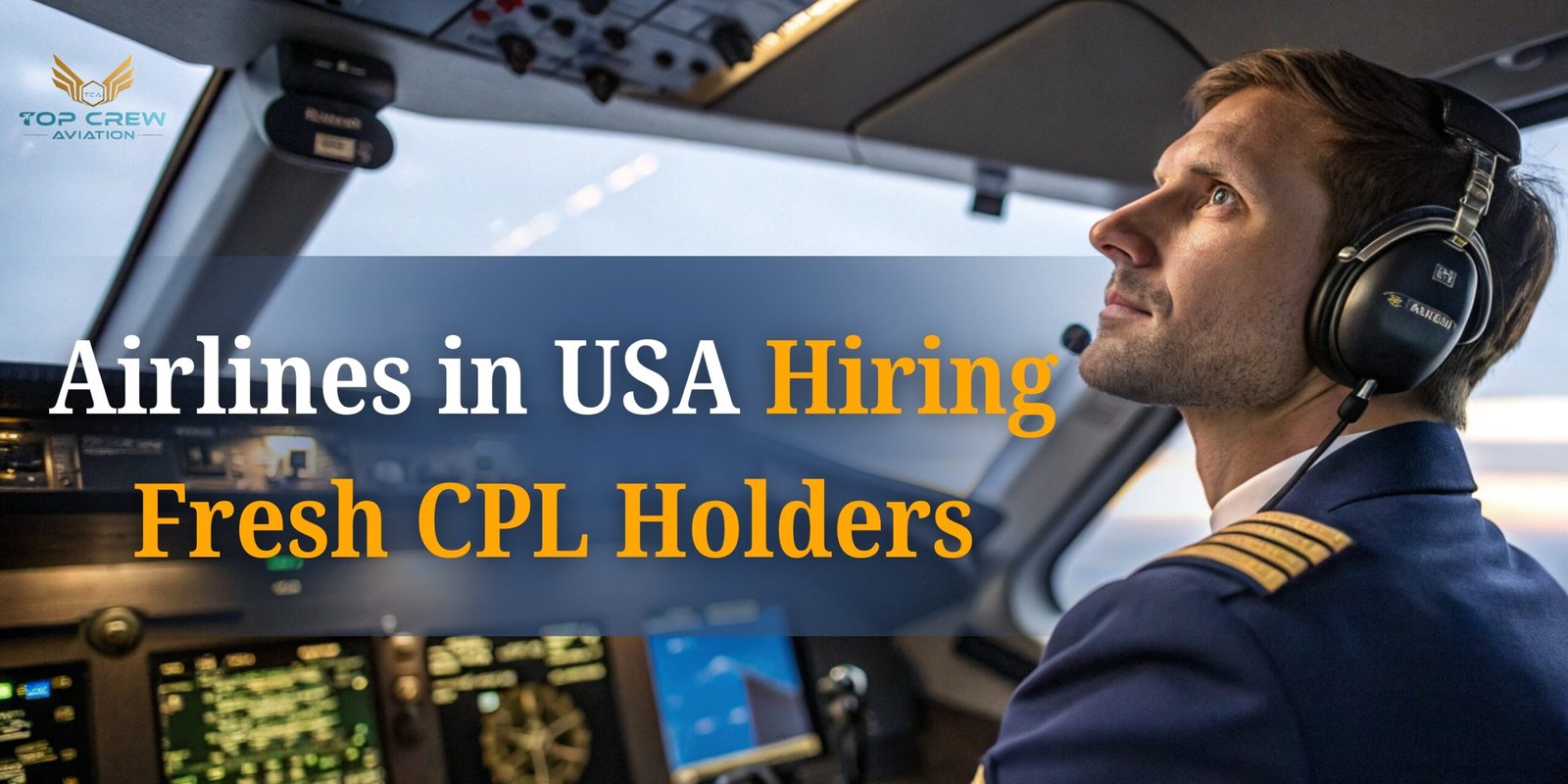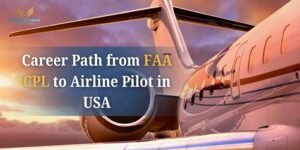Introduction
Imagine sitting in the cockpit of a big jet, ready to take off with hundreds of passengers on board. Sounds amazing, right? For many new pilots who have just earned their Commercial Pilot License (CPL), this is the dream. But the big question is — can you really get hired by an airline in the USA right after getting your CPL?
In this blog, we’ll explore how airlines in the USA hire fresh CPL holders, what qualifications they look for, how you can build flight hours, and what steps you can take to move toward your dream airline job.
Whether you’ve just finished flight school or are planning to start, this guide will give you clear, practical steps. You’ll learn about airline requirements, how to convert your license if needed, and how to stand out as a new pilot.
So, if you have your CPL in hand (or are close to getting it) and are wondering, “Can I join an airline in the USA now?”, then you’re in the right place. Let’s take off and explore your pilot career path together!
Understanding the Situation: Are U.S. Airlines Hiring CPL Holders?
What the hiring situation is right now
Yes, airlines in the USA are hiring pilots — especially regional airlines. However, getting hired with a fresh CPL (meaning low flight hours and little airline experience) is not always easy.
Here’s why:
- Major U.S. airlines usually want pilots with an Airline Transport Pilot (ATP) certificate, not just a CPL.
- Some smaller or regional airlines may accept CPL holders, but they often expect additional flight hours or participation in a pathway program.
- The term “fresh CPL holder” can mean different things — some pilots may have only the minimum hours, while others have more experience.
What this means for you
If you’re a new CPL holder:
- You can aim for U.S. airline jobs, but major airlines may not hire you immediately.
- Focus on regional airlines or pathway programs that are made for new pilots.
- Understand that most airlines want a minimum of around 1,500 flight hours before hiring.
- If your CPL is from another country, you may need to convert it to an FAA license.
Key Takeaway:
Some U.S. airlines do hire CPL holders — but you’ll usually need more experience and the right ratings. It’s not an instant jump from flight school to a major airline.
Requirements: What Airlines Really Look For
Minimum Licenses & Certificates
When applying to U.S. airlines, you’ll need:
- A valid CPL (converted to FAA if trained outside the U.S.)
- Instrument rating and multi-engine rating
- Class 1 medical certificate (FAA standard)
- Eventually, an ATP certificate for major airline jobs
Flight Hours & Experience
Airlines care most about your flight hours — not just your license.
Here’s what they usually expect:
- Regional airlines: 1,000–1,500 flight hours
- Major airlines: 1,500+ hours or ATP-certified
- Some special programs let you start with lower hours, as long as you commit to building them over time
Other Qualities Airlines Check
- Strong training records and instructor endorsements
- Good decision-making and communication (CRM skills)
- Clean medical and regulatory record
- Authorization to work in the U.S. (citizenship or visa)
- Strong interview and simulator performance
| Requirement | Regional Airline (First Officer) | Major Airline (First Officer) |
| License | CPL + Instrument + Multi-Engine | CPL → ATP |
| Flight Hours | ~1,000–1,500 hrs | 1,500+ hrs (ATP) |
| Medical | Class 1 Medical | Class 1 + Type Rating (later) |
| Other | Good training record | More experience + interview skills |
Why this matters:
Knowing these requirements helps you plan your next steps — what ratings to get, how many hours to build, and what type of airline to target.
Pathways for Fresh CPL Holders to U.S. Airline Jobs
Step-by-Step Guide
- Get your CPL – Complete flight training, exams, and licensing.
- Build flight hours – Work as a:
- Flight Instructor (CFI)
- Charter or sightseeing pilot
- Banner tow or survey pilot
- Pipeline or ferry pilot
- Flight Instructor (CFI)
- Upgrade your ratings – Add instrument and multi-engine ratings, then aim for your ATP when ready.
- Join a pathway program – Many U.S. flight schools and regional airlines have cadet or training programs that guide you from low-hour pilot to airline-ready first officer.
- Apply and interview – Prepare your resume and practice your interview and simulator assessments.
- Start with a regional airline – Gain real-world experience, then move to a major airline.
Real-Life Example
Let’s say John just earned his CPL with 300 hours.
He becomes a CFI, builds 1,200 hours in a year, earns his ATP, then joins a regional airline under a cadet program. After a few years, he qualified for a major U.S. carrier.
That’s the realistic, proven path most pilots follow.
Key Tips for CPL Holders
- Choose schools with airline connections.
- Record every flight hour (especially PIC, multi, and instrument time).
- Network with other pilots and recruiters.
- Be open to relocation or smaller aircraft early on.
- Focus on gaining experience, not just salary, in the beginning.
Why this works:
This path lets new CPL holders move step-by-step from “new pilot” to “airline-ready.” It builds your skills, confidence, and qualifications for U.S. airline jobs.
Challenges for Fresh CPL Holders (and How to Beat Them)
Common Problems
- Hour requirements: You might need more hours than you have.
- License conversion: Non-U.S. CPLs require FAA conversion.
- High competition: Many pilots are applying for limited seats.
- Cost: Building hours can be expensive.
- Slow hiring: Big airlines often prefer experienced pilots first.
How to Overcome These
- Start building hours immediately — work as a CFI or charter pilot.
- Aim for regional airlines — they’re more open to new CPL holders.
- Join cadet programs — structured paths that lead to airline jobs.
- Budget smartly — treat early jobs as career investment.
- Understand FAA conversion early if trained abroad.
- Stay current — keep your medical and instrument ratings active.
| Challenge | Solution |
| Not enough hours | Build hours via CFI or charter work |
| Non-U.S. CPL | Research and complete FAA conversion |
| High competition | Build extra ratings, network actively |
| Cost | Plan and save — view early roles as stepping stones |
| Slow hiring | Focus on regional carriers first |
Example:
One pilot said online, “There’s nothing out there for wet CPLs.” It’s true that airlines rarely hire zero-experience pilots — but if you start instructing, charter flying, or join a pathway program, you can reach your goal faster.
Tips to Stand Out and Increase Your Chances
Be Airline-Ready Early
- Create a clear, professional resume with your CPL, ratings, and total hours.
- Highlight teamwork, communication, and safety skills.
- Keep your medical certificate and logbook updated.
- Attend career fairs and pilot networking events.
Use the Right Keywords
When applying, use language that fits the industry:
- “CPL holder with multi-engine and instrument ratings”
- “Seeking entry-level regional airline opportunity”
- “Focused on building flight hours and advancing to ATP”
Prepare for Airline Interviews
- Study common interview and simulator questions.
- Practice explaining your career plan — how you’ll grow from CPL to ATP.
- Be confident, honest, and professional.
Example Checklist for Fresh CPL Holder
- Valid CPL
- Instrument & multi-engine ratings
- Class 1 medical certificate
- Logbook with flight hours
- Updated resume
- Interview prep done
- Target airline programs shortlisted
Why this matters:
By showing you’re prepared and serious, you stand out among applicants. Airlines prefer pilots who plan ahead and understand what’s expected of them.
What to Expect After Getting Hired
Your First Months
When you join your first airline (likely regional), you’ll go through:
- Aircraft type-rating training
- Line training (flying with a trainer)
- Safety and CRM training
- Regular check rides and performance reviews
This stage builds your confidence and helps you adjust to airline life.
Building Your Career
Once you’re flying regularly:
- Keep building hours and experience.
- Apply for promotions within your airline.
- Continue training and simulator practice.
- Once qualified, apply to major U.S. carriers for bigger roles.
| Year | Career Stage |
| 0–1 | Get CPL, start your building |
| 1–2 | Gain ratings, join regional airline |
| 2–5 | First Officer, build experience |
| 5+ | Move to major airline, aim for Captain role |
Staying Focused
- Track your progress regularly.
- Set short-term (6-month) and long-term (5-year) goals.
- Stay flexible about job location and pay.
- Learn from senior pilots and mentors.
Summary:
Once you’re hired, the journey truly begins. Focus on learning, performing well, and steadily moving toward your long-term airline goals.
Conclusion
If you’re a new pilot looking for airlines in the USA hiring fresh CPL holders, now you know the full picture. It’s not an instant process — but with the right steps, it’s completely possible.
Meet the requirements, build your hours, join the right programs, and stay ready. Start today by reviewing your flight hours, checking your ratings, and applying to regional or pathway programs.
With consistency, patience, and smart planning, your CPL can open the door to a successful airline career in the U.S.
Your cockpit seat is waiting — so get ready for take off!



